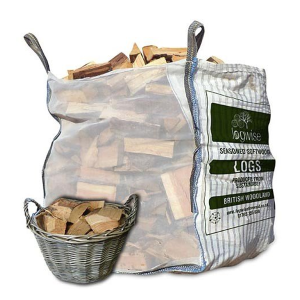A guide to cooking on a log fire
As the weather starts to get warmer, it’s time to start getting back outdoors and enjoying time in nature. Whether you’re camping or hiking or just sitting in your garden, nothing finishes an outdoorsy day like cooking over an open fire.
Cooking on a log fire isn’t just for boy scouts. It’s a fun, social experience to enjoy with friends and family and man, does the food taste delicious.

When it comes to log fire cooking there are a few things you have to take into account to ensure your safety and scrumptious food.
In this article, we have put together all the top tips for successful and tasty log fire cooking.
Choosing the right firewood
As fun as it might seem to go off into the woods to gather your own wood and kindling, the levels of moisture in the wood you collect will create a huge amount of smoke with a fire that generates very little heat.
You are much better off purchasing dry, seasoned firewood logs which will create minimal smoke when burned and will generate enough heat to ensure your food is thoroughly cooked.
Finding the best location
You can’t just start a fire anywhere, so choosing the right location is a must.
The most ideal spot would be on the floor of a cave but, given that most of us don’t have access to caves, choose a spot that’s on bare mineral soil.
If you are using a fire pit, however, you can pretty much set your fire up anywhere.
If you are at a campsite they may already have established fire pit areas so do use those as the heat of your fire pit could burn the ground.
Wherever you are setting up, try to choose a location that is sheltered from the wind and not too close to trees and vegetation as a fly away spark could cause a forest fire.
Patience is a virtue
When it comes to cooking on a log fire, patience is definitely a virtue. A good cooking fire will be made up of hot coals and a few good, dry, seasoned logs.
Once lit you will need to wait at least 30 minutes for the fire to burn down so that the coals are hot enough for cooking. Once the fire has burned down you can occasionally add logs to keep it going.

There is no need to make a particularly big fire either. A larger fire will burn through all your logs too quickly and you will be left with only coals that will quickly get too cool for cooking.
Don’t cook with the flames
Whilst you can roast marshmallows directly in the flame, for proper food you are going to want to make use of the hot coals.
Cooking the food over the flames will leave your food burnt on the outside and raw on the inside.
Instead, build your fire so one side is flames and the other is for hot coals that you can circulate in and out. Put a camp grill above the hot coals and you can roast your burgers, sausages and veg. You can also wrap vegetables in foil and place them on the coals to cook.

It’s also worth mentioning that you don’t need to cook the food as long as you’d expect. Because of the heat generated by the flame, the food will continue to cook for a short time after it’s taken off the grill.
Take the food off just before you think it’s ready and let it finish cooking by itself for a few minutes before tucking in. Always check that meat is piping hot throughout before eating, too.
Avoid fatty, oily foods
Food like steak, bacon and anything that requires oil to cook should be avoided as the oil can cause sudden flare-ups in the fire which can obviously be quite dangerous and could lead to you or someone else being badly burned.
Have a bucket of water handy
This is a rule you should keep any time you light an open fire for any purpose. Even the most carefully built and sheltered fire has the potential to get out of control and having a bucket of water at the ready means you can quickly put the fire out if it starts to behave.

We also recommend pouring water over it when you are finished so that the hot coals don’t ignite when it’s left unattended.
And there you go, all the hot tips for cooking on a log fire. So get out of the kitchen and start cooking outdoors!
















